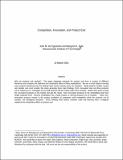| dc.description.abstract | Why do products exit markets? This paper integrates rationale for product exit from a number of different literatures and compares the statistical and substantive effect of these explanations. We use a novel dataset covering
every product introduced into the desktop laser printer industry since its inception. Using hedonic models, hazard rate models, and count models, this study generates three main findings. First, innovation does not drive products
out of market per se. Managers do not pull products off the market when they innovate. Rather they seem to keep the incumbent products on the market and add the newer, more innovative products to the marketplace that have longer expected lives. Second, competition has a large impact on driving products out of markets. These noninnovative products remain in the product portfolios of companies until competition drive the products out of markets, not managerial decisions. Third, holding other factors constant, scale and learning have a marginal statistical and substantive effect on product exit. | en |
